Knowing goat care basics to ensure effective goat keeping, since it will determine how one is devoted to making sure that he or she is caring goats the proper way.
Here is a basic step –by –step goat care process that those interested needs to take into heart.
Step 1 is to provide shelter for your goats. It does not mean that purchasing your goats and making them graze on a grassy field is enough to make them productive. The most appropriate goat shelter is a three- sided barn with a pitched roof which is disgnated an area for a flooring made of straw or dry bedding.
Step 2 is to make sure that that your goats are feeding from a clean feeder where they are not able to in which could soil the feed.
One can never be sure what sort of organisms reside in the ground your barn is located in, so always make sure to provide appropriate shelters with provisions to prevent your goats from ingesting contaminated feed or living conditions vulnerable to the proliferation of harmful microorganisms or parasites.
Step 3 is to provide fresh water daily to goats, since goats are a picky lot and will not drink water that they feel is not clean or if the drinking vessel is not clean so always make sure to avoid goats from getting dehydrated.
Step 4 is to regularly check hooves of goats every month and always -trim as needed. As you continue to do so, be wary of signs of hooves that shows signs of rotting. Always make sure to clean and remove rotted hooves to prevent it from spreading and damaging the goat’s hooves.
Step 5, since goats consume either fresh grass or warm straw, it is never far from the fact that parasitic worms may have been carried through the feeding process, thus it is also appropriate to always de -worm your goats at least twice a year, using a paste wormer since it is easier to administer compared to powdered, liquid or capsulized dewormer.
Step 6 is to always be aware and watch for lice which could infest goats unless it is carefully checked, as well as dust, which could also be a common carrier for microscopic creatures that can be dangerous to your goats.
Step 7 is to always partner with a veterinarian, one that is located close to your territory and one that can be available to readily administer vaccination shots or emergency treatment for your goats. This is more appropriate in caring for goats to produce milk for human consumption.
This must be done on a regular basis since milk sourced from goats may also carry parasitic worms or other organisms that dwell inside the goat’s body, especially those that are not regularly checked or treated for deworming, as well as vaccination shots.
Last step is to make sure to shave goats during the summer months, especially during warm seasons, since goats also need to sustain a good temperature that would not allow the goats to become more agitated and affected their productivity.
So knowing goat care basics to ensure effective goat keeping is indeed your best friend in your venture.






No comments:
Post a Comment